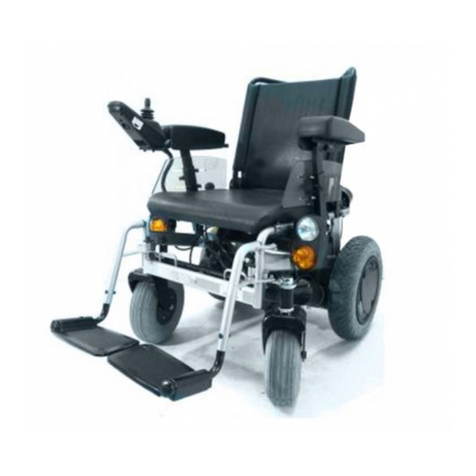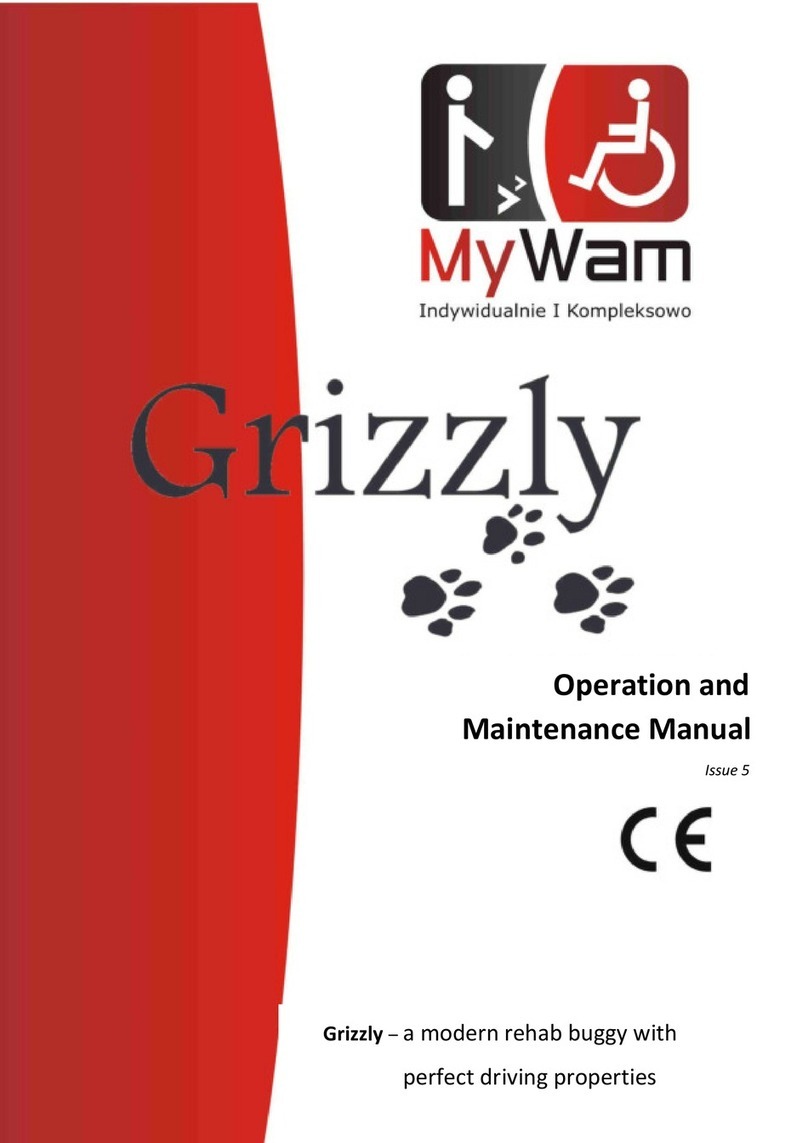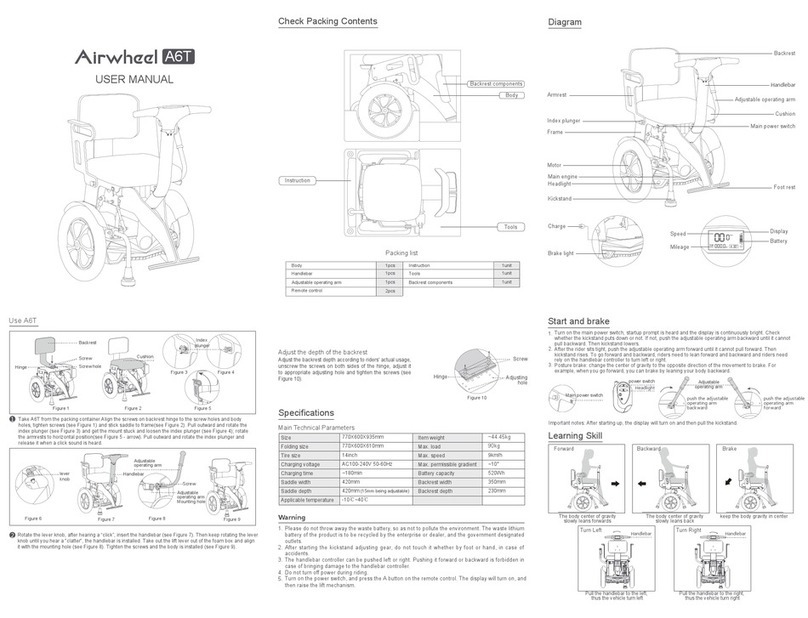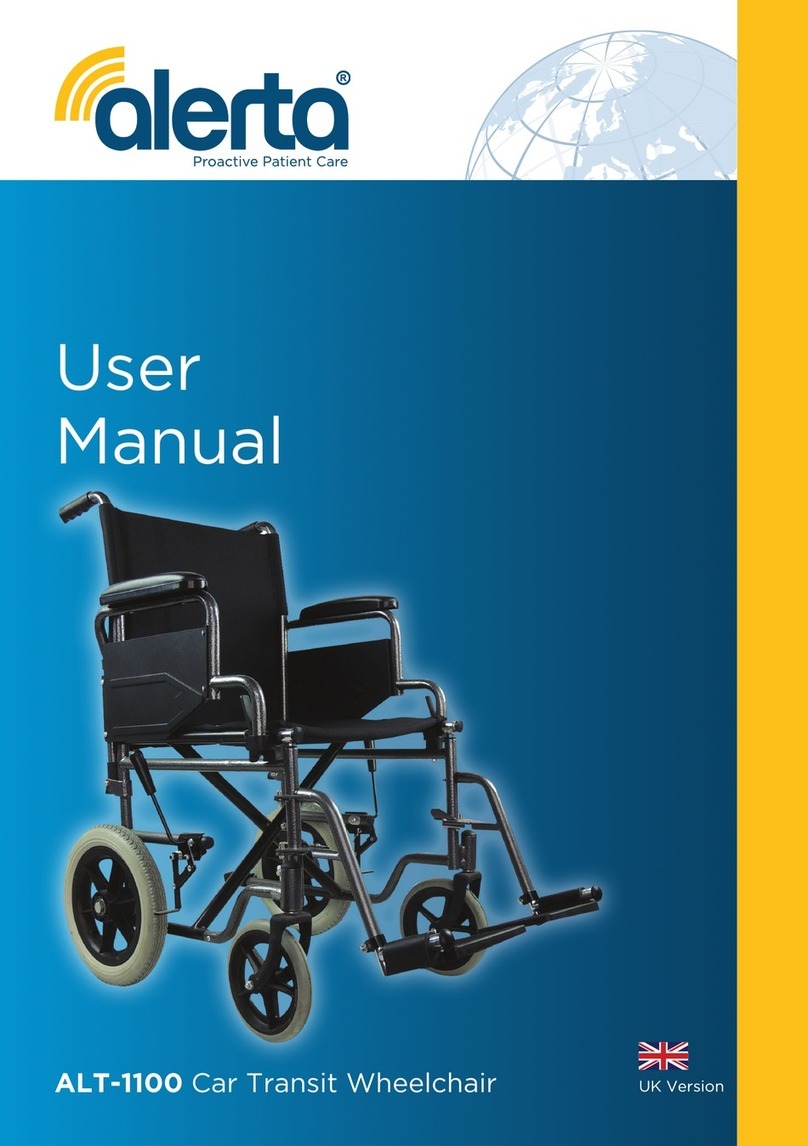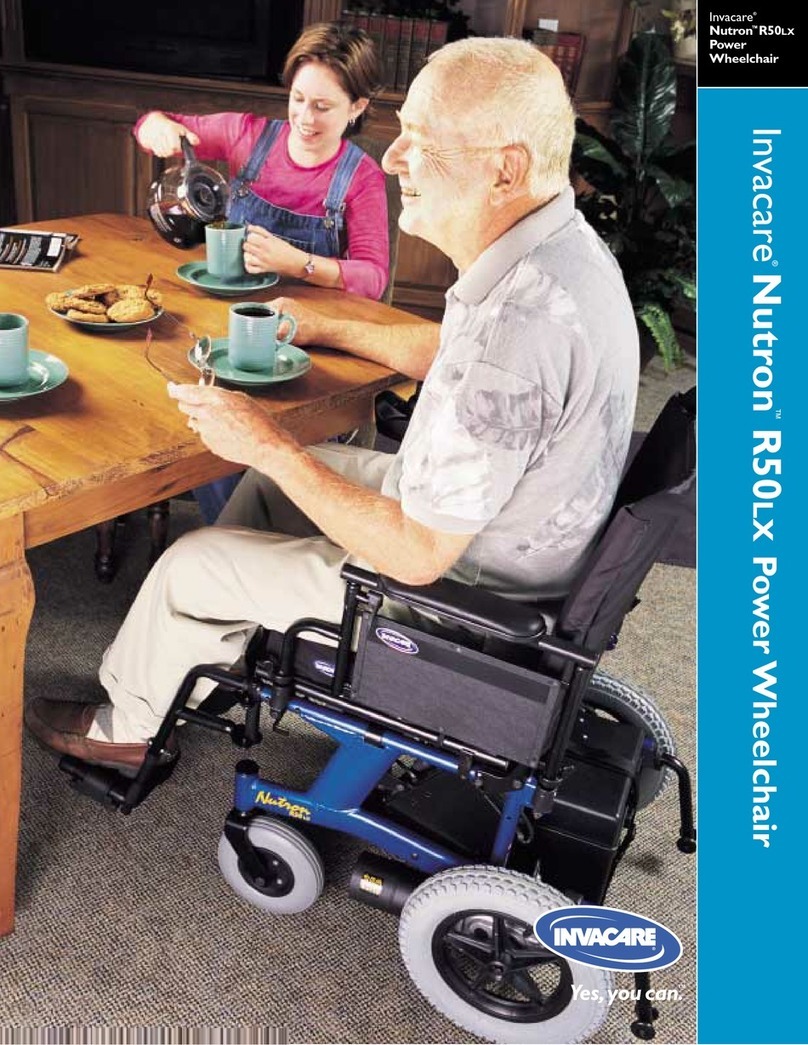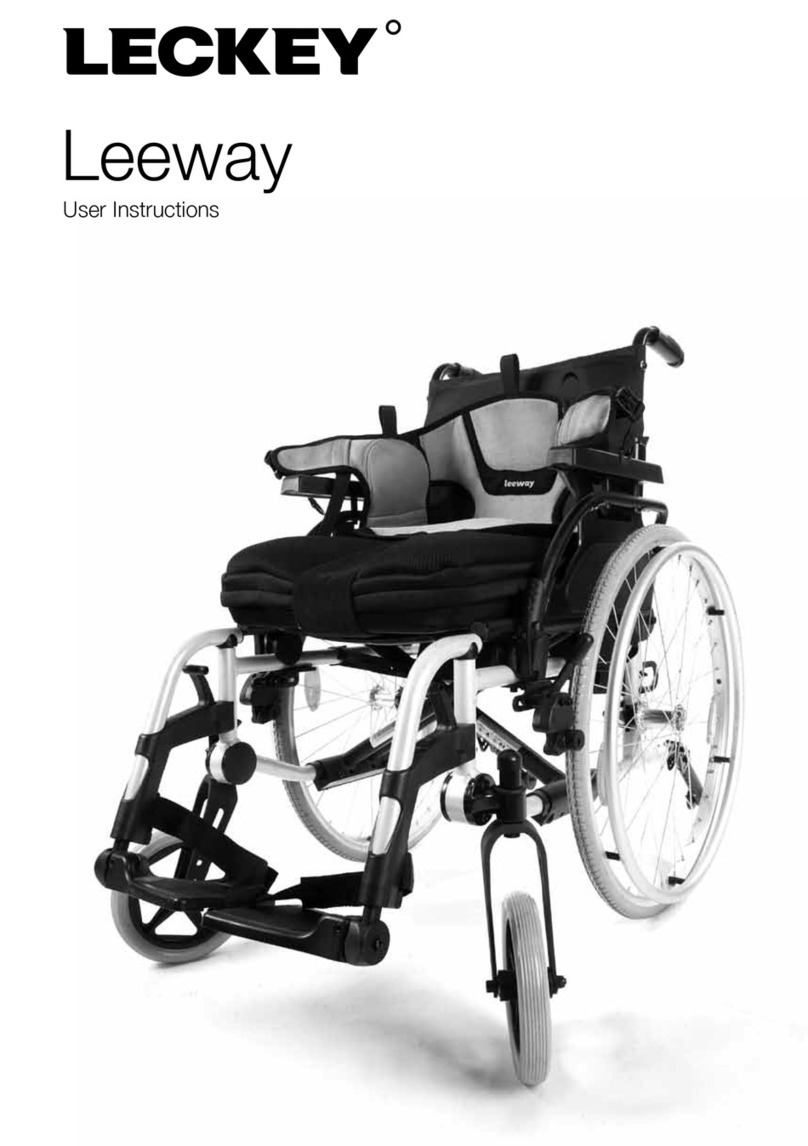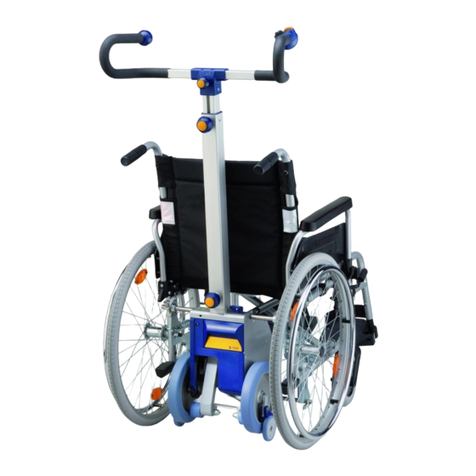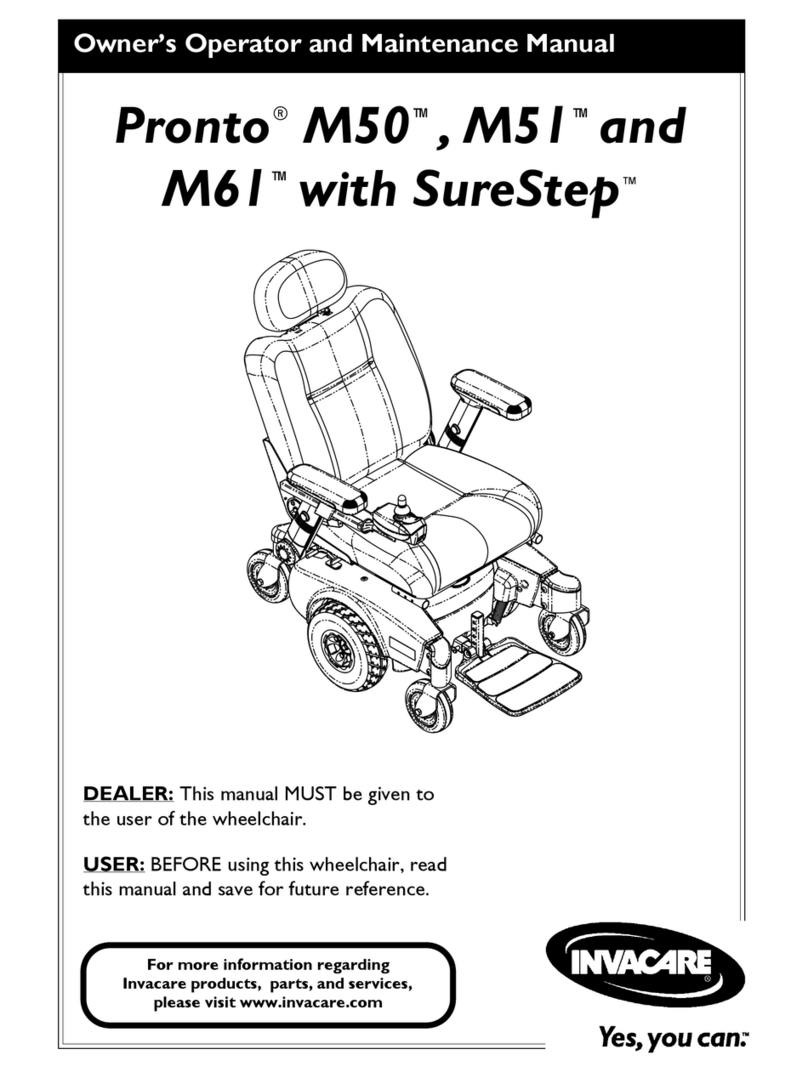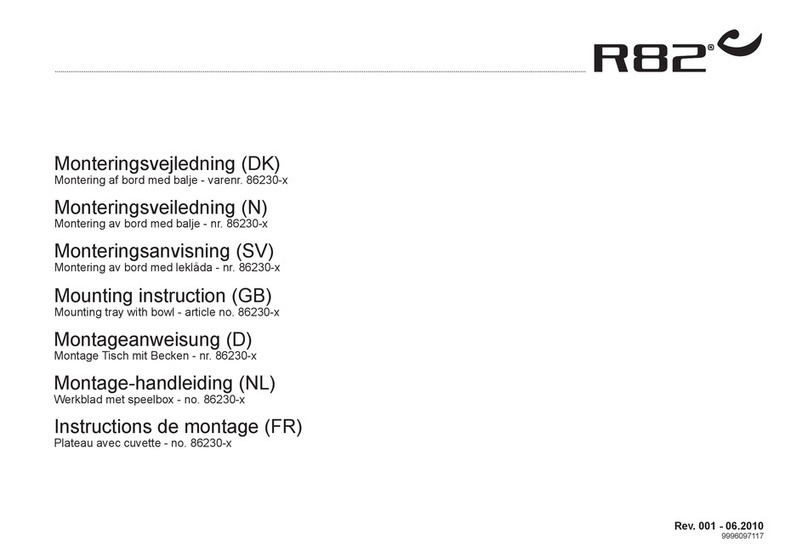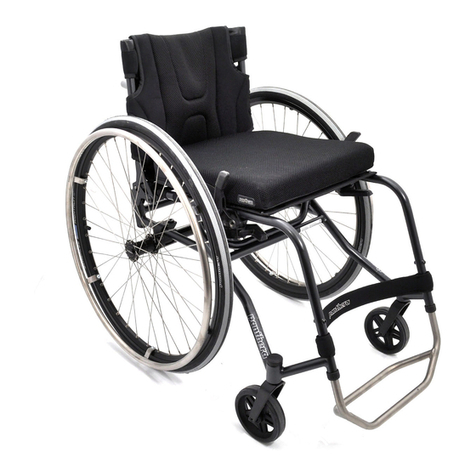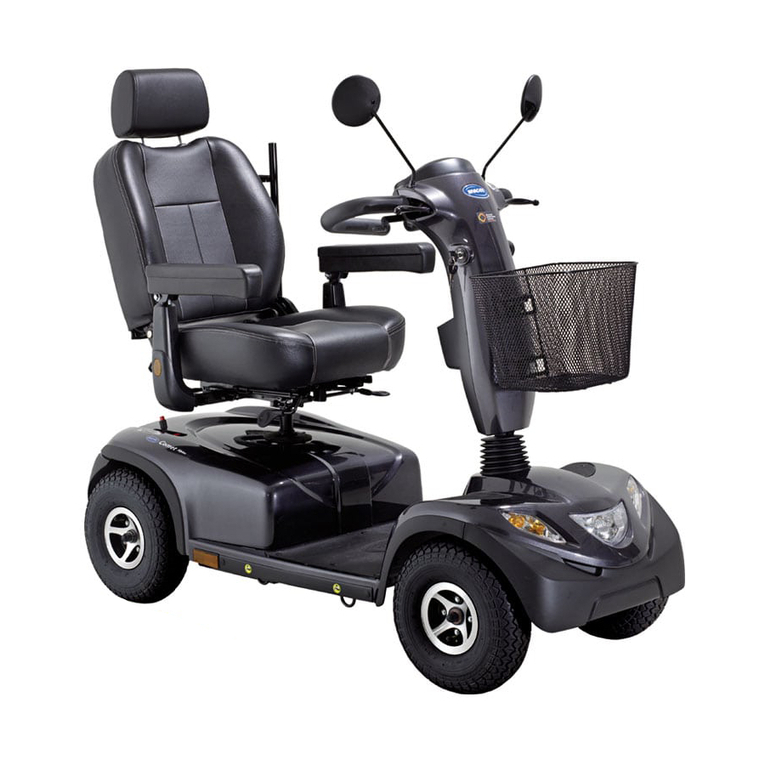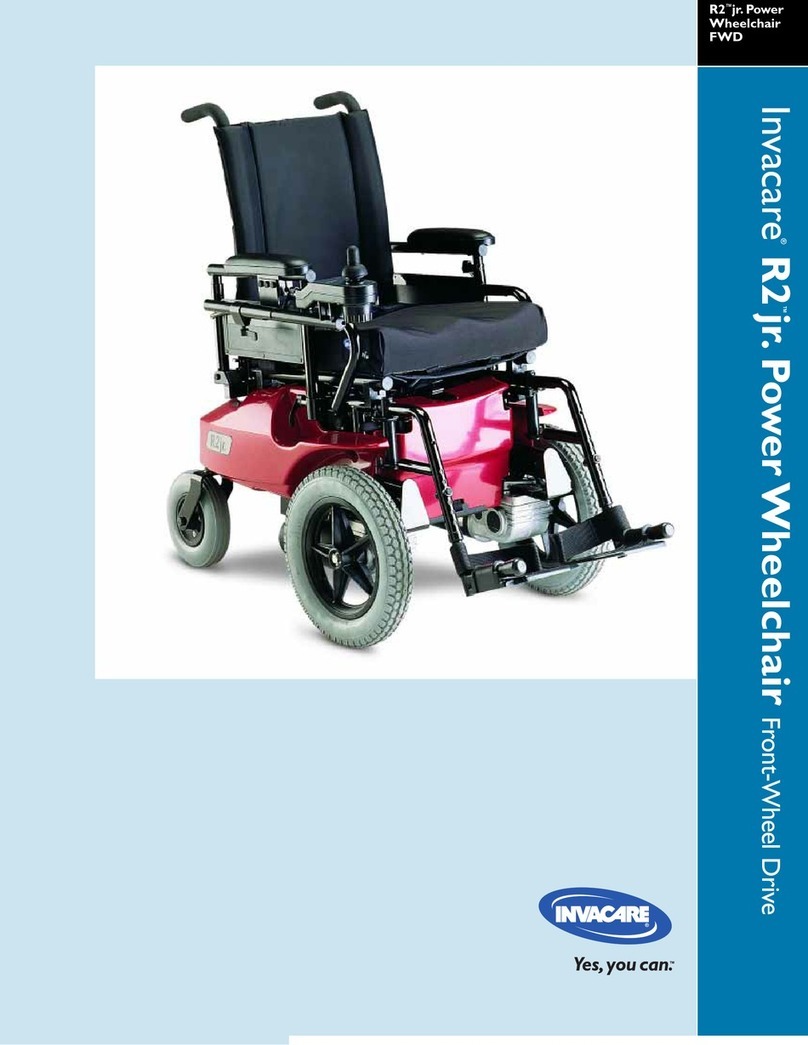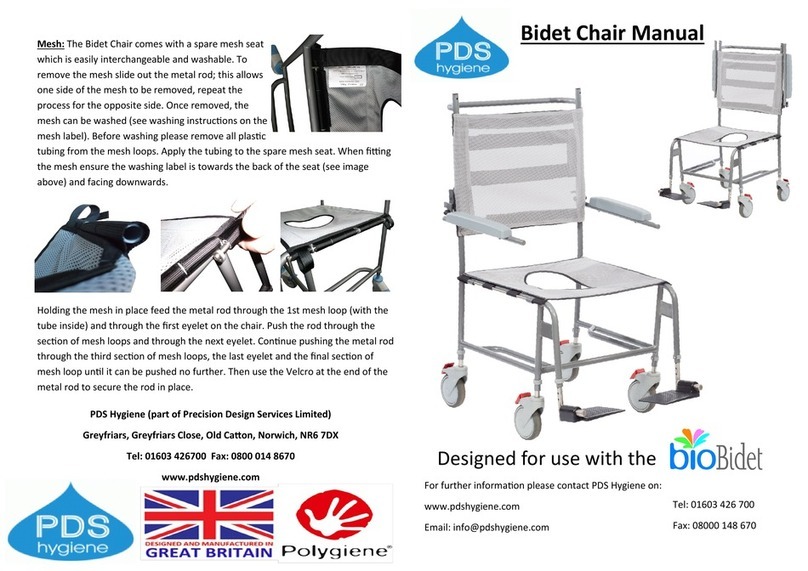Meyra 1.620 User manual

en
Operating manual
We move people.
Electric wheelchair
Model 1.620

2

3
Contents
Meaning of the applied markers 7
Introduction 7
List of models 7
Indications and contraindications 7
Specifications 8
Use 8
Adjustment 9
Statutory regulations 9
High-frequency radiation 10
Overview 11
Model 1.620 11
Basic safety information 12
Accompanying person 12
Transfer out of the wheelchair 12
Reaching for objects 12
General safety information 13
Emergency braking 13
Initiating the emergency braking 13
Transfer out of the vehicle 14
Curve driving 14
Driving on falling, rising or transverse gradients 14
Crossing obstacles 15
Transport in public methods of transportation 15
Handling the electric wheelchair 16
Securing the electric wheelchair 16
Functional checks 16
Driving 16

4
Brakes 16
Service brake 16
Braking the wheelchair 16
Parking brake 17
Locking the brakes 17
Releasing the brakes 17
Drive-/push mode 18
Selecting the push mode 18
Selecting the motor mode 18
Selecting the operation 19
Pre-operation checks 21
Battery charging procedure 21
Positioning the operating module 22
Function description 22
Adjusting the distance to the padded arm support 22
Removing the operating module 22
Inserting the operating module 22
Swivelling the operating module 23
Arm supports 24
Lowerable arm support 24
Swivelling up the arm supports 25
Swivelling down the arm supports 25
Back support 26
Back support upholstery 26
Head support 27
Adjustment of the head support 27
Removing and height adjusting the head support 27
Adjusting the head support during handicapped transport inside a motor vehicle 27
Leg support 28
Footboard 28
Knee cushions 29
Removing/attaching the knee cushions 29

5
Side cushions 30
Adjusting the side cushions 30
Removing the side cushions 30
Inserting the side cushions 30
Seat 31
Special safety information for raising the seat, seat height adjustment,
standing and lying functions 31
Seat pad 31
Seat inclination 31
Electrically adjusting the seat angle 31
Seat height adjustment 32
Standing function 33
Lying function 34
Chest strap 35
Fastening the chest strap 35
Opening the chest strap 35
Shoulder strap 36
Fastening the shoulder strap 36
Adjustment of belt length 36
USB connector socket 37
Rear-view mirror 38
Removing the rear-view mirror 38
Attaching the rear-view mirror 38
Adjusting the rear-view mirror 38
Lighting 39
Loading and transportation 39
Loading 39
Ramps and lifting platforms 39
Transport of people inside a motor vehicle 40
Transport security 40

6
Maintenance 40
Maintenance 40
Maintenance schedule 41
Fuses 43
Replacing the fuses 43
Lighting 44
Headlights 44
Fault correction 45
Service 46
Tyres 46
Cleaning and maintenance 46
Upholstery and covers 46
Disinfection 47
Reinstallment 47
Repairs 47
Customer Service 47
Spare parts 47
Disposal 48
Information for the specialist dealer 49
Programming the driving behaviour 49
Technical data 50
Maximum range 50
Hill climbing ability 50
Values acc. to ISO 7176-15 for model 1.620 51
Further technical data for model 1.620 52
Meaning of the labels on the electric wheelchair 54
Meaning of the symbols on the washing instruction 55
Meaning of the symbols on the type plate 56
Inspection certificate 57
Warranty / Guarantee 58
Warrantee / Guarantee section 59
Inspection certificate for transfer 59

7
MEANING OF THE AP-
PLIED MARKERS
Safety instructions with a coloured back-
ground are mandatory and need to be
observed under any circumstance!
☞This symbol indicates tips and recom-
mendations.
[ ] Reference to a picture number.
( ) Reference to a function element within
a picture.
INTRODUCTION
Read and observe this manual before first
operation. Children and juveniles should
read this documentation together with
their parents respectively a supervisor or
accompanying person before first use.
This operating manual is to help you get ac-
customed to the handling of the wheelchair
as well as to prevent accidents.
☞Please note that the illustrated equip-
ment variants can deviate from your
model.
We have therefore also listed chapters with
options that might not be applicable for
your vehicle.
Users with visual impairments can find the
PDF-files together with further information
on our website:
< www.meyra.com >.
☞Contact your specialist dealer when re-
quired.
Information about product safety, possible
recalls and general handling instructions of
our products can be found in the < Informa-
tion center > on our website:
< www.meyra.com >.
LIST OF MODELS
This operating manual applies to the follow-
ing models:
Model 1.620
INDICATIONS AND
CONTRAINDICATIONS
With physical handicaps, e.g. blindness as
well as doubtful cognitive qualification, a
driving certificate for independent driving
of the wheelchair is required.
In case of allergic reactions, skin rashes
and/or pressure sores during the use of
the wheelchair sores contact a doctor im-
mediately.
Mobility products of this category serve in-
dependent mobility or transport through
third persons, in constant or during a longer
period sufficient walking ability exists.
Decisive for this is:
☞The handicap compensation to fulfil
basic needs.
– Independent mobility in the apartment
an in domestic environments.
– Leave the home for short walks in order
to reach the generally close to home
available areas in which to carry out
daily affairs.
☞Protection from handicaps, resp. pre-
ventable secondary diseases.
– Protection from joint contractures,
– Protection from decubiti,
– Protection from lung diseases such as
pneumonia,
– Protection from premature joint degen-
eration caused by false strain.

8
For some of the indications special equip-
ment variants may be required on the aid,
such as:
– special handrims,
– electric adjustment options,
especially for highly complex provisions,
this can extend to the physiological correct
standing and lying position.
The appropriateness of the aid as well as
the extent of requirements is constituted
through the doctors prescription, often
combined with the consultation protocol of
a therapist or medical device adviser.
SPECIFICATIONS
The electric wheelchair is an environ-
ment-friendly electric vehicle. The electric
wheelchair was developed for adolescents
and adults, in order to increase their limited
action radius due to health or age depend-
ing problems.
The model has been assigned the 'Use Class
B' as per the EN12184 standard. The electric
wheelchair with active footboard and arm
support units serves solely to transport
one seated person and not as a pulling aid,
transporter or similar.
USE
Do not reach onto the turning surface of
the wheels or grip the tyres of the rotating
wheels. – Danger of injury!
The wheelchair is driven through the joy-
stick integrated in the operating module.
Refrain from jerky starts with your wheel-
chair. – Danger of tipping over or tilting!
Do not use the wheelchair without the
lowered footboard or when the arm sup-
port units are removed!
Avoid driving on inclinations or slopes
with insufficient surface condition.
The wheelchair is applicable on level, firm
surfaces and can be used as follows:
– for indoors (e.g. apartment, day care),
– outdoors (e.g. paved paths in parks),
– as a companion on tours (e.g. in a bus
or train).
– Never expose the wheelchair to ex-
treme temperatures and damaging
environmental conditions, such as sun-
light, extreme cold or salty water.
– Sand and other dirt particles can seize
on moving parts and render them with-
out function.
You must not let yourself be carried in your
wheelchair by having the wheelchair lifted
from the floor. Parts that are not secure-
ly fixed, e.g. arm support units, can come
away and thus cause an accident.
☞The wheelchair is a vehicle and not a
carrying device.
Only apply the wheelchair within the
scope of the specifications and limitation
described in chapter Technical data on
page 50.

9
ADJUSTMENT
Always have adaptation and adjustment
work carried out by a specialist dealer.
The wheelchair offers manifold adjustment
possibilities to individual vital statistics.
The wheelchair should be adapted to your
needs by a specialist dealer before the first
use. The adaptation will take into account
the driving experience, the physical limits of
the user and the main place of use of the
wheelchair.
☞We recommend a regular control if
the wheelchair adjustment in order to
ensure a long-term optimal provision
even with changing illness/handicap
patterns of the user. Especially for chil-
dren and juveniles an adjustment every
6 months is recommendable.
☞We recommend regular medical checks
for independent determination of the
driving ability.
STATUTORY
REGULATIONS
Please comply with the legal requirements
of the country in which the wheelchair is
used.
☞The road traffic regulations and road
traffic liscencing regulations (StVO resp.
StVZO) are valid in Germany.
☞Inform yourself at your specialist dealer
or the road traffic authorities about the
legal regulations concerning the opera-
tion of your electric wheelchair.

10
HIGH-FREQUENCY
RADIATION
Our electric vehicles are conform with the
corresponding requirements of the EG-di-
rective 93/42 EWG for medical devices. Nev-
ertheless Interferences from high frequency
rays of other electric devices cannot gener-
ally be ruled out.
Despite tested protective measures on the
electrical equipment of the vehicle, distur-
bances in the operation cannot be ruled out
when driving through extreme electric In-
terferences. These are manifested in strange
driving behaviour. If the electric wheelchair
reacts uncontrollably in such a case or if oth-
er electronic devices (such as for example
highly sensitive, electromagnetic devices
such as anti-theft units in shopping centres)
are influenced by the vehicle, stop imme-
diately and switch the electric wheelchair
off. Never drive the electric wheelchair in
the proximity of electronic medical equip-
ment with a high danger potential and/or
life-supporting function or in the proximity
of diagnostic equipment.

1 2 3
4
11
16
15 14
6
5
10 7
8
13
9
12
11
OVERVIEW
Model 1.620
The overview shows the most important
components and operating devices of the
electric wheelchair.
Pos. Description
(1) Head support
(2) Back support
(3) Arm support
(4) Seat pad
(5) Knee pad
(6) Footboard
(7) Steering wheel
(8) Type plate
(9) Selection lever drive-/push mode
(10) Driving wheel
(11) Operating module
(12) Side cushion
(13) Front lighting
(14) Rear lighting
(15) Support castor
(16) Electronic cover

12
BASIC SAFETY
INFORMATION
This safety information is an extract of
the Safety and general handling instruc-
tions, that can be found on our website:
< www.meyra.com >.
Do not insert fingers into open frame
tubes (for example after removing the
arm supports, leg supports or support
castors). – Danger of injury!
A stable sitting position is to kept while
using the wheelchair, even when not in
motion and especially on hills and slopes.
– Danger of accident!
In a safe sitting position the back of the
user lies directly on the back support up-
holstery and the hip of the user is at the
back end of the seat.
Transit out of the wheelchair on hills/
slopes may only be carried out in emer-
gencies and with the aid of an accompa-
nying person and/or helper! – Danger of
accident!
Increased danger of tipping over when
using the angle adjustable back support.
Before starting to drive make sure that no
negative seat inclination has been adjust-
ed, respectively that a safe seating posi-
tion is ensured.
Accompanying person
The accompanying person must be made
aware of all possible danger situation before
the start of his/her supportive involvement.
The parts of your wheelchair that are held
onto by the accompanying person are to be
checked for tight fit.
Transfer out of the wheelchair
Drive with the wheelchair as closely as pos-
sible to the spot where you want to switch
out of the wheelchair.
☞We recommend to conduct the trans-
fer from the wheelchair together with
an aid.
Reaching for objects
Avoid an extreme forward or backward in-
clination of the upper body when picking
up or placing heavy objects. – Danger of
wheelchair tipping over, especially in the
case of narrow seat widths and high seat
heights (seat cushion)!

13
GENERAL SAFETY
INFORMATION
☞Do not drive into water with the vehicle.
☞Do not insert fingers into open frame
tubes (for example after removing the
leg supports or operating module).
– Danger of injury!
☞A secure sitting position is to be kept
while driving the electric vehicle even
during stillstand and especially on hills/
slopes. – Danger of accidents!
☞In a safe sitting position the back of the
user lies directly on the back support
belt/-cushion and the hip of the user is
at the back end of the seat belt/-cush-
ion.
☞Never reach into the swivel area of the
components when operating adjust-
ment devices, e.g. back support or leg
supports. There is a danger of injury
through squashing.
☞Exposure to direct sunlight can cause
seat covers/upholstery, arm support
pads, leg supports and handles to heat
up to over 41 °C. – Contact with ex-
posed skin can result in injury! Prevent
such heating by parking the wheelchair
in a shaded area.
☞Existing electric or manual adjustments
are to be adjusted for the drive mode in
such a fashion that a secure handling of
the vehicle is warranted.
☞A back support reclined to the rear or a
seat raised at the front generally bears
the risk of tilting over in drive mode.
☞With push mode engaged the vehi-
cle can no longer be driven or braked
down through the joystick/director.
– Danger of accidents!
☞A fastened retaining strap can provide
you with the necessary safety (also view
Emergency braking on page 13). Do
not undertake journeys alone if pos-
sible so that you can always have the
assistance of a helper in problem situ-
ations!
☞In case you encounter an emergency
situation, we recommend an emergen-
cy call system suited to your disability.
Emergency braking
The danger of injury during an emergen-
cy braking is especially great if your are
disadvantaged by imperfect osteogen-
esis or similar syndrome. You must then
drive very carefully in order to avoid this
danger situation!
The strong deceleration of the vehicle dur-
ing an emergency braking can hurl you
forwards out of the vehicle if your physical
condition cannot prevent this. You can pre-
vent this by wearing a retaining strap.
Initiating the emergency braking
Release the joystick and switch the elec-
tric vehicle off. The vehicle will brake down
abruptly on a short distance.

14
Transfer out of the vehicle
☞Entering or exiting the electric vehi-
cle may only occur when the vehicle
is switched off and the parking brake
activated resp. drive mode achieved
through the selection lever.
☞When transferring never support your-
self on the operating module.
Curve driving
There is a danger that the vehicle can veer
from the course, resp. tilt over!
☞Principally choose a driving speed that
is adequate for the curve radius, mean-
ing never to drive into curves too quick-
ly.
☞In order to always have a lateral sup-
port during curve driving, never drive
without side elements (arm supports),
respectively only with correctly adjust-
ed side elements (arm supports) which
give lateral support to the body.
Driving on falling, rising or trans-
verse gradients
For safety reasons, the maximum permitted
gradient is limited because the tip-over sta-
bility and the braking and steering behav-
iour are impaired by a reduced floor/road.
☞Observe chapter Technical data on
page 50.
☞Always drive with a low speed on ris-
ing/falling gradients.
☞Extreme inclinations or slopes are to be
driven on with adequate final speed.
☞Never switch to push mode on gradi-
ents. The automatic brakes are inoper-
ative in the push mode.
☞Do not push the vehicle on gradients.
☞Do not lean towards the downhill di-
rection when driving on rising, falling
or transverse gradients.
☞Do not adjust the seat or back support
angle on rising and falling gradients.
– Danger of overturning!
☞While driving in curves and when turn-
ing on inclinations and slopes there is a
danger of tilting.
☞Avoid jerky changes of the driving con-
dition (especially with critically adjusted
driving parameters as for example high
delay values).
☞Never move the drive/push mode se-
lection lever, to the push mode posi-
tion whilst driving uphill or downhill!
The vehicle will then roll downhill un-
controllably, without being able to be
steered and can only be stopped with
the parking brake.
☞Avoid driving on inclinations or slopes
with insufficient surface condition. Even
with only on sided existence of ice, wa-
ter, moss or similar on the ground, there
is a danger that the vehicle will loose
traction and begin to slide out of con-
trol. If required immediately bring the
joystick into the neutral position and
additionally activate an existing hand-
brake on the vehicle in order to elimi-
nate the dangerous situation.

15
Crossing obstacles
Check the vehicle and all exposed cables
for damage after a collision with an obsta-
cle!
☞For overcoming obstacles with the help
of ramps please also observe chapter
driving in elevators and lifting platforms
and the general safety and handling in-
structions on our website:
< www.meyra.com >.
Transport in public methods of
transportation
Use the space designated by the public
transportation services for parking.
Your electric vehicle is not designed for user
transport in public transportation vehicles.
Limitations may occur. We recommend use
of one of the firmly built in seats of the pub-
lic vehicle.
Should it nevertheless become necessary to
carry out the transport while sitting in the
electric vehicle, the following needs to be
observed:
☞Use the space designated by the public
transportation services for parking.
☞Observe the regulations of the trans-
port company before parking the elec-
tric vehicle..
☞Park your electric vehicle opposite to
the driving direction in the reserved
space.
☞The electric vehicle is to be placed so
that the back support it will be support-
ed by the border of the parking space.
☞One side of the wheelchair must addi-
tionally lie near a further border of the
parking space, so that the electric vehi-
cle cannot slide to the side in case of an
accident or sudden braking motion.
☞Additionally activate the parking brakes
and switch the electric vehicle OFF.

16
HANDLING THE ELECTRIC
WHEELCHAIR
Only transfer into or out of the electric
wheelchair when the electric wheelchair
is switched off and the selection lever
drive-/push mode on both sides is in drive
mode!
An unintentional movement of the joy-
sticks (driving and steering lever) can oth-
erwise lead to an uncontrolled start of the
electric wheelchair! – Danger of accident!
Securing the electric wheelchair
The electric wheelchair is to be secured as
follows to prevent it from rolling off unin-
tentionally:
1. Switch the selection lever for drive-/
push mode up to drive mode on both
sides.
2. Switch off the operating module.
Functional checks
The functions and safety of the electric
wheelchair must be checked before the
start of each journey.
☞For this observe chapter < Inspections
before starting to drive > in the accom-
panying documentation.
Driving
You define the speed and direction yourself
with the joystick movements (driving and
steering lever) while driving as well as the
preadjusted maximum final speed of your
electric wheelchair.
☞Therefore observe operation manual
< Operating module >.
BRAKES
Brake the vehicle down carefully and in
time. This is especially the case when driv-
ing in front of people and while driving
downhill!
Service brake
The motors work electrically as operating
brake and carefully brake the electric wheel-
chair down without jerks to stillstand.
Braking the wheelchair
For allotted braking of the wheelchair slow-
ly guide the joystick (steering and driving
lever) back to the centre position (zero-set-
ting).
☞The electric wheelchair stops in short-
est distance after releasing the joysticks.
Braking distance
In delivery condition the braking distance
is according to the maximum values of EN
12184:
– 1.0 m with 6 km/h,
– 1.5 m with 8 km/h,
– 2.1 m with 10 km/h,
– 2.9 m with 12 km/h,
– 4.5 m with 15 km/h.
The braking distance may get longer de-
pending on the road conditions or the con-
dition of the tyres.

1
2
17
Parking brake
The parking brakes are only effective when
the selection lever drive-/push mode is set
to drive mode on both drives. They disen-
gage automatically when the wheelchair
starts off.
The parking brakes are manually disen-
gaged by switching the selection lever
drive-/push mode on both drives to push
mode.
Locking the brakes
It should not be possible to push the elec-
tric wheelchair forward when the brakes
are engaged.
To engage the brakes swivel the selection
lever drive-/push mode on both sides as far
as possible into drive mode [1].
☞Activation of the selection lever is in-
tended for an accompanying person.
Releasing the brakes
To loosen the brakes swivel the selection le-
ver drive-/push mode on both sides down
as far as possible into push mode [2].
☞Activation of the selection lever is in-
tended for an accompanying person.

2
1
18
Drive-/push mode
Only switch the electric wheelchair to
push mode when it is standing still for
positioning or in case of emergencies, but
not on slopes/hills.
After push mode do not forget to switch
the drive back to drive mode. Danger of
uncontrolled electric wheelchair move-
ment if you do not do this.
☞Grab hold of the push handle and back
support in order to shunt the electric
wheelchair.
Selecting the push mode
1. Switch off the operating module be-
cause the pushing will otherwise be
made difficult by the electric system.
☞Therefore observe operation manu-
al < Operating module >.
2. Disengage the brakes [1].
☞Therefore observe chapter Releasing
the brakes on page 17.
☞The electric wheelchair can now be
pushed.
Selecting the motor mode
1. Activate the brakes [2].
☞Therefore observe chapter Releasing
the brakes on page 17.
2. Switch the operating module on.
☞Therefore observe operation manu-
al < Operating module >.
☞The electric wheelchair is now ready
for use again.

2
1
19
SELECTING THE
OPERATION
In order to obtain operational readiness of
the electric wheelchair the following direc-
tions are to be carried out in the indicated
order.
☞Charge the drive batteries via the oper-
ating module before the first journey.
1. Selecting the motor mode
Switch the drive motors to the drive mode
[1]. – For this engage the brakes.
☞Observe chapter Locking the brakes on
page 17.
2. Check the correct fit of the battery/
mains fuse
Blade-type fuse:
The blade fuse for the battery/main current
has to sit tightly in the fuse holder (2).

4
3
20
3. Position of the operating module
The operating module should be posi-
tioned in such a way that you can comfort-
ably and safely steer the electric wheelchair.
Adjusting the distance to the padded arm
support:
After the adjustment retighten the clamp-
ing screw. – Therefore observe chap-
ter Positioning the operating module on
page 22.
The distance of the operating module to
the padded arm supports can be adjusted
after loosening the clamping screw (3).
4. Switch the operating module on
Press the ON/OFF-key (4) on the control
panel of the operating module.
☞Therefore observe operation manu-
al < Operating module >.
Other manuals for 1.620
1
Table of contents
Other Meyra Wheelchair manuals

Meyra
Meyra EUROCHAIR 2 THE ORIGINAL 2.750 User manual

Meyra
Meyra 1.750 User manual

Meyra
Meyra 2.322 User manual

Meyra
Meyra iChair DYNAMIC 1.623 User manual

Meyra
Meyra EUROCHAIR 2 PRO 2.850 User manual
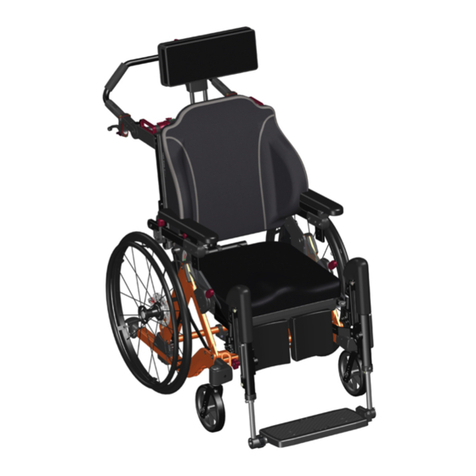
Meyra
Meyra Netti DYNAMIC AdaptPro User manual
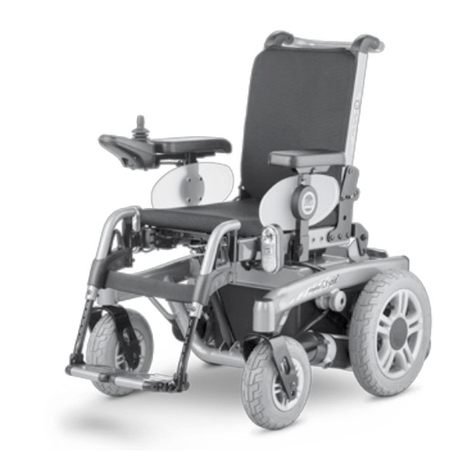
Meyra
Meyra 1.610 User manual
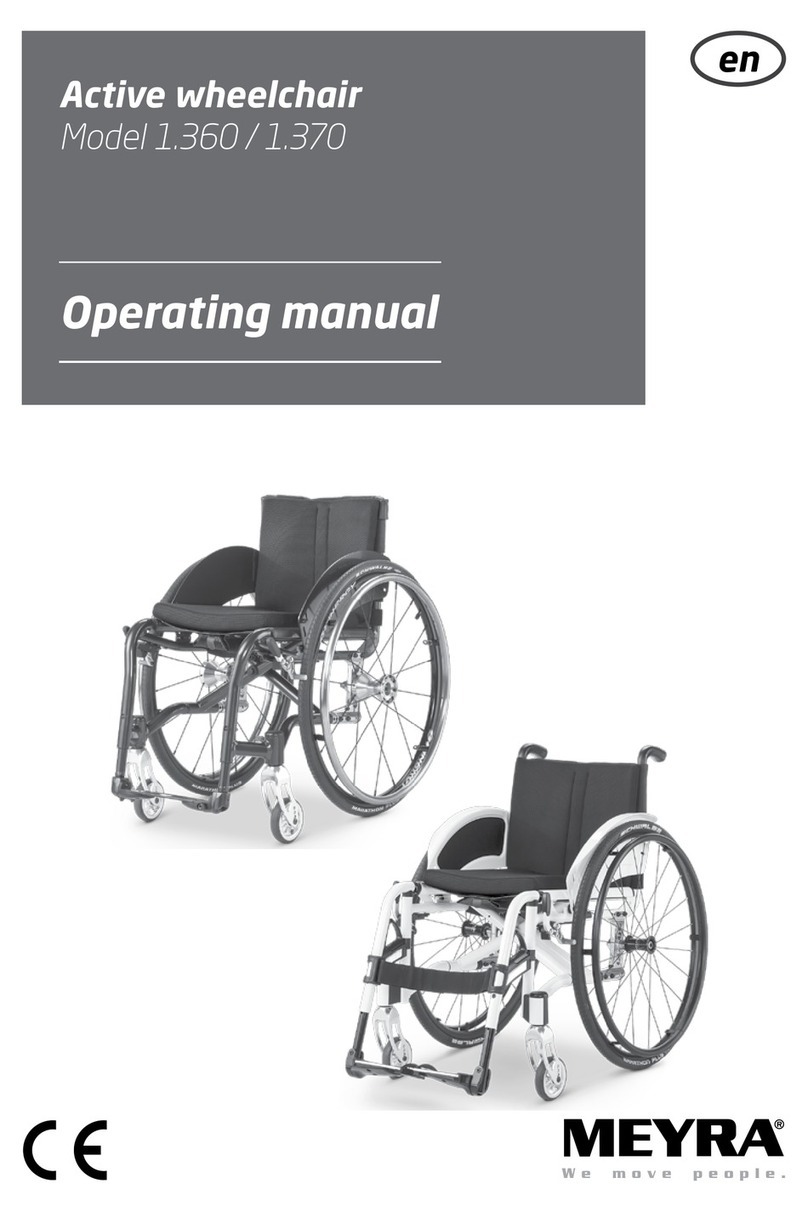
Meyra
Meyra 1.360 User manual

Meyra
Meyra Optimus User manual

Meyra
Meyra 2.432 User manual
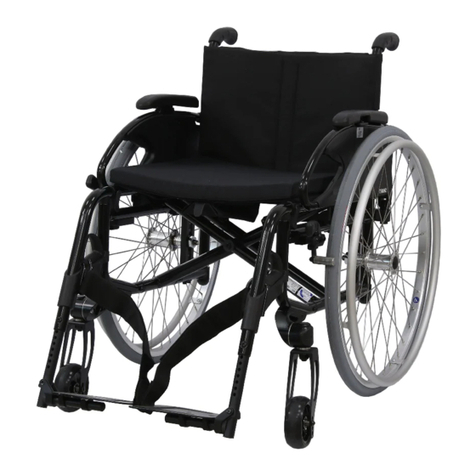
Meyra
Meyra 2.360 User manual
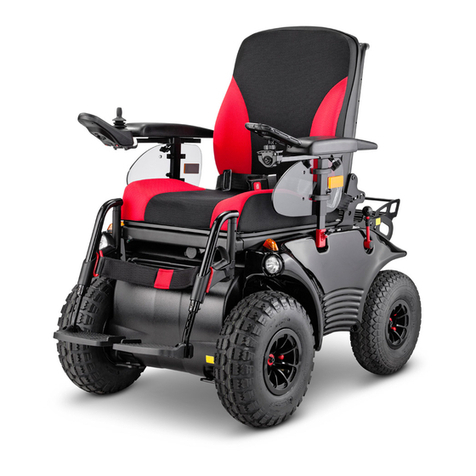
Meyra
Meyra Oprtimus 2 User manual
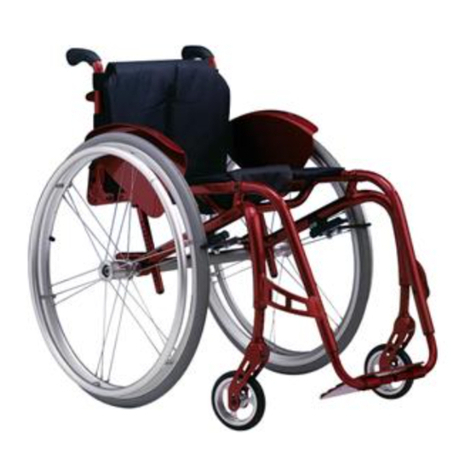
Meyra
Meyra FX One 1.150 User manual
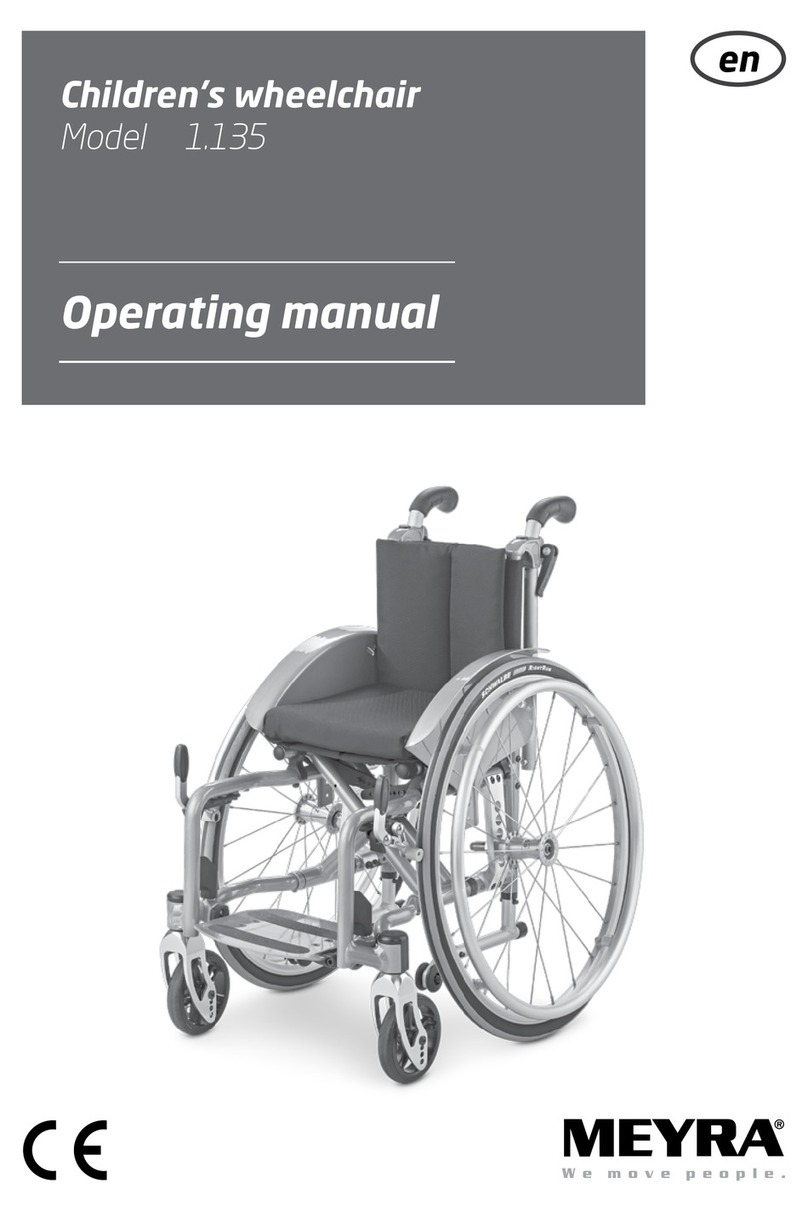
Meyra
Meyra 1.135 User manual

Meyra
Meyra Eurochair2 2.750 User manual

Meyra
Meyra 1.620 User manual

Meyra
Meyra Optimus 2 User manual

Meyra
Meyra 2.845 User manual
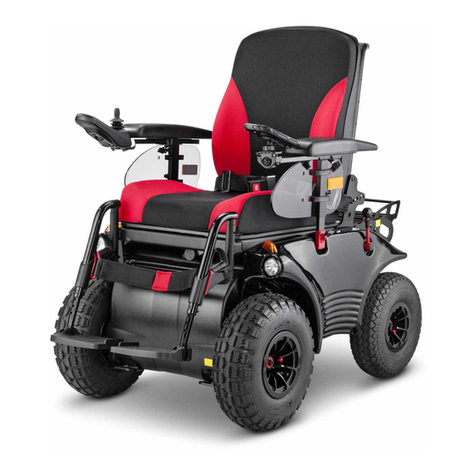
Meyra
Meyra 2.322 User manual
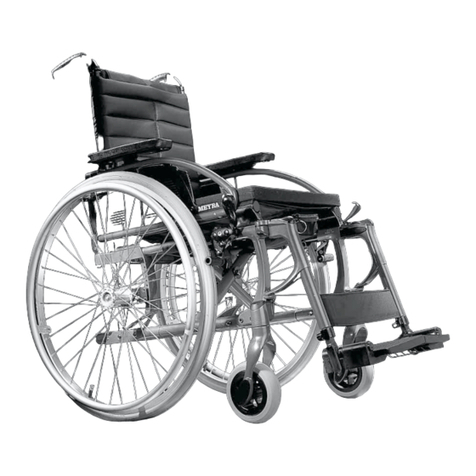
Meyra
Meyra Primus 2 3.310 active User manual


